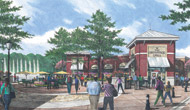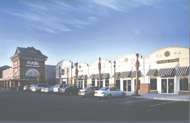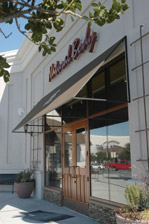|
COVER STORY, MARCH 2005
GROW…AND THEY WILL COME
Second-tier markets in North Carolina and South Carolina step up to the plate.
Karen Stone
 |
The village area at The Shops at Greenridge, which Crosland is
developing in Greenville, South Carolina. |
|
North Carolina and South Carolina are having a day in the sun, basking in that special place where growth is steady, the climate is temperate, the living is easy, the population is well educated and has disposable income, and land and development costs have not yet risen into the red zone. Charlotte, North Carolina, has led the growth and, according to Ryan Preston, director of leasing for Crosland, Inc., “Charlotte has done an excellent job of bringing in major employers that will continue to reinforce the strength of our region.”
Second- and third-tier markets are now beginning to benefit from this successful marketing. “Retailers are beginning to look at markets such as Burlington, Spartanburg and Florence,” says Lyle Darnall, vice president of development for the Southeast for Edens & Avant. “For example, in Florence, we redeveloped a major mall and added discounters to the traditional anchors. In second-tier markets, there is ample room for retailers to do business because there is not as much competition at this time.”
Dove-tailing on the home run streaks of Charlotte and Raleigh, North Carolina, second-tier markets are getting their chance at bat — and coming up with solid base hits.
The Lead Hitters
The overall trend in the Charlotte market is “up and all over.” Revitalization of the Charlotte central business district continues, and plans are underway to redevelop the Charlotte Convention Center area to include high-rise residential communities and big box retail developments.
The north Charlotte area is home to one of the only new malls being built in the country — the 1.1 million-square-foot Northlake Mall, which will open in spring 2006. Its primary competitor, Southlake Mall, was just renovated at a cost of $1.1 million, and 180,000 square feet is being added to the Carolina Mall power center in Pineville.
 |
A new development of James Doran Company.
|
|
Ground-up retail development activity is strongest in the suburbs. “We are seeing a large increase in new centers fueled by solid consumer spending and our vast housing market that is expanding through the roof,” says Tom McMahon, senior advisor and owner of Sperry Van Ness/McMahon and Associates (Sperry/McMahon). Crosland is building the 495,000-square-foot Blakeney mixed-use center anchored by Target and Harris Teeter, scheduled to open in second quarter 2006. Sperry/McMahon is in the beginning stages of developing a 68-acre tract in Troutman, North Carolina, between Statesville and Lake Norman. The project will total 250,000 square feet and will house several big box users and a strip center.
Two new power centers are underway: one in Huntersville at Northcrest, located at Interstate 77 and Exit 25, and one in southwest Charlotte at Steel Creek. Edens & Avant is developing an 80,000-square-foot grocery anchored center in Davidson, scheduled to open in 2006.
Retail development activity in the Raleigh/Durham area has been more than brisk. Kane Realty is taking on one of the largest developments, North Hills. As part of this open-air, mixed-use district, Kane is developing 730,000 square feet of upscale retail. By spring of this year, 65 shops and restaurants will be open. In addition, Crosland is developing Poyner Place, a 478,000-square-foot mixed-use center anchored by SuperTarget, projected to open in August of this year.
Midland Atlantic is currently building Renaissance Village at Southpointe Mall, which includes 300,000 square feet of retail as well as office and hotel components. Midland is also on the move in the Cary submarket, where it has submitted plans for an 85-acre mixed-use development.
Other Raleigh suburbs have also had an active year, and Kahn Development has been a major player in several submarkets. Kahn is beginning on Phase II of Wake Forest Crossings just north of Raleigh. In the southwest suburb of Apex, Kahn recently completed Haddon Hall Commons, a 73,500-square-foot center anchored by Harris Teeter. At Highway 41 and Southhall Road, Kahn is beginning work on a mixed-use development that includes 60,000 square feet of retail.
Second-Tier Climbers
The big news in the Columbia market is The Village at Sandhill, which is featured in the sidebar on page 46. Alan Kahn, president of Kahn Development, says his company chose the site because “the population of northeast Columbia doubled from 1990 to 2000, making it one of the hottest markets right now.”
 |
Kane Realty Corporation is developing the 730,000-square-foot North Hills in Raleigh/Durham, North Carolina.
|
|
Edens & Avant agrees. In 2004, it redeveloped most of an old, underutilized mall close to downtown Columbia and built a 200,000-square-foot open-air center anchored by Target, Bed Bath & Beyond, World Market and Pier 1 Imports. Edens & Avant is also currently building the 240,000-square-foot Lexington Pavillion, scheduled to open in the summer of 2007.
After a late 90s boom and a somewhat quiet start to the new century, Charleston seems to have caught its breath and is poised for action. Already up and growing is Daniel Island — the hot spot between Mount Pleasant and downtown Charleston. Daniel Island has been Number 1 in home production in the Charleston area for the past 3 years, with 800 to 1,000 homes being built annually. James Doran Company is developing Downtown Daniel Island, a multi-phase center anchored by Publix that will total 170,000 square feet when completed. “Our tenants are doing very well, “ says Pete Harper, COO. “Our plan is to build right with demand, to pace it, not to force it.” James Doran Company is carefully evaluating the needs of the Island’s affluent population, which retains an average household income of $120,000. “We are focused on bringing more brand, regional restaurants (and top retailers) to the island.”
Kane Realty is transforming University Mall in Chapel Hill from a “center with typical regional mall tenants into a 360,000-square-foot enclosed specialty center with a good roster of upscale retailers and restaurants,” according to John Kane, CEO. The departure of Belk “gave us the opportunity to truly reinvent University Mall by adding A Southern Season as an anchor.”
Bill Misiaveg, vice president of Carolina Holdings, Inc., describes Greenville as “a great market with a lot of activity.” Crosland is developing a 600,000-square-foot regional shopping center, The Shops at Green Ridge. Centennial American Properties is developing a 100,000-square-foot center across the street that will include Whole Foods and Circuit City. In Simpsonville, Isaacson/Barnhart of Atlanta is beginning work on a large mixed-use project.
“Give me air, lots of air….”
The new mall currently being built in northern Charlotte is the exception, rather than the rule for the Carolinas, and for the country as a whole. Lifestyle centers and other open-air formats are much more common today. Crosland’s Preston notes, “Many traditional ‘mall tenants’ are finding great success in these projects developed in areas where the demographic makeup supports shopping but other limiting factors will prevent a large enclosed mall.” Bob Spratt of Hill Partners comments, “The open-air center allows an alternative venue, requiring less intense development than malls, but still providing high quality space.”
According to Darnall of Edens & Avant, “Interest seems to be primarily in lifestyle centers — they use less land and can be more personal and boutique-like in nature.” Alan Kahn of Kahn Development concludes, “We are following the ‘transformation of retailing’ and retailers are finding out that their concepts can work better in open-air centers, with far less CAM, easier access, direct visibility, (door-front) parking and streetscape amenities.”
According to Mike Wiggins, senior vice president of development for Crosland, “Smaller unanchored centers (also) abound due to site adaptability and lower cap rates.” Spratt adds, “And not just in major markets, but also in second tier markets like Columbia and Wilmington.”
Urban infill is most prevalent in Charlotte and is gaining momentum in Columbia and Greenville. This trend may expand into other cities as a result of the new TIF legislation passed in November of 2004. John Silverman, managing partner of Midland Atlantic notes, “Revitalization is a very important part of the long-term success of a community. The new TIF legislation. . . will provide a real benefit to attracting in-town redevelopment.”
Developers Follow Retailers
Developers are bullish on the Carolinas because retailers are showing an increased interest in a larger number of markets. And retailers are bullish on the Carolinas because their populations are growing — in a good way.
Over the past several years, steady, “good” job growth has led to strong residential growth. Growth has also occurred through “in-migration of more affluent northerners due primarily to the temperate climate,” reports Croslands’ Wiggins. “This yields more disposable spending dollars for retailers. This in turn supports higher sales per square foot, which accommodates higher rents and rental growth. (This region also) has lower barrier to entry issues than other more urban areas. In general, it is easier to develop here because the authorities are more pro-development than bigger cities with more stringent rules.”
Spratt adds, “Because land and development costs are lower in the Carolinas in general, and the approval process is less restrictive, holding costs are lower over a shorter period of time and this attracts developers.”
Mike Munn of The John R. McAdams Company thinks that “Central North Carolina was severely underserved for a long time. It is now catching up to the population growth.” Christian Chamblee with Ziff Properties suggests the Carolinas remain underretailed. “There are less consumer choices here than other areas with similar demographics,” Chamblee explains. “New retailers have a unique opportunity to take advantage of an underserved market that is willing to embrace new concepts and ideas.”
Retailers Follow Rooftops…
…and rooftops are being raised at a good, steady pace. In addition, according to Wiggins, “Certain (developing) trade areas…have a higher median household income than almost anywhere else in the country — some over $100,000 per household.” Because of the relative affluence of the population, Silverman adds, “retailers have historically done well in these areas.” According to Kane, “the shopper base is sophisticated and well traveled and has experience with some of the world’s best retailers in other markets”, and welcomes these retailers to their backyards.
Retailers are also in line to claim their spots in several growing niche markets. Pinehurst, North Carolina, was intentionally designed to look like “a little bit of New England tucked into the North Carolina hills to attract wealthy northerners who want to head South for more than just the winter,” according to Marty MacKensie, president of The Olmstead Village Company. The theory has worked, since the area is thriving and retailers have followed.
In contrast, Barefoot Landing in Myrtle Beach was designed to attract vacationing families and “it has become one of the leading tourist attractions in South Carolina,” says Spratt, who leases and manages the center. Designed to look like a seaport village nestled into the pristine, natural, coastal environment, the 300,000-square-foot center is visited by more than 9 million people a year.
Sperry/McMahon has just begun marketing of an upscale lifestyle center, the Shoppes at Willow Falls, in Boone, North Carolina. “Interest in the area has been spurred by Appalachian State University and interest from national and local tenants is strong”, says McMahon. “The setting is extremely unique and features a 75-foot waterfall tumbling down from a natural mountain setting.”
Hot or Not?
There is a general consensus that growth in the Carolinas has followed a pattern of what Spratt calls “next logical growth.” Harper of James Doran Company agrees: “Retailers seem to be developing their stores in line with calculated and paced growth plans.”
Yet, in this logical growth scenario, some markets are hotter than others. “Greenville, South Carolina, had above normal high wage growth.” says Wiggins, and development activity has followed. Spratt notes, “Columbia, South Carolina, is seeing a lot of activity. And Myrtle Beach is very active.” Kahn thinks that “Northeast Columbia is the hottest market right now,” and adds Charleston and Hilton Head to the list of hot coastal areas.
There are a few “sleeper” markets according to Kane, including areas in those “smaller municipalities (in the Raleigh area) like Garner and Apex, and the north Raleigh areas around Brier Creek Commons and Triangle Town Center …that are seeing an explosion in retail growth in big box centers.” Wiggins suggests we keep our eyes on Bluffton, South Carolina, which will “produce the next open air mall in the Carolinas.”
The Glow Will Continue
The factors that are catalyzing growth in the Carolinas are firmly in place and don’t appear to be changing soon. The affluent demographics and comparatively lower occupancy costs will continue to attract development activity. For now, the hits continue to fly high in the Carolinas, creating a sure win for retailers and developers.
Karen Stone, CCIM, president of Stone Consulting Group, is a commercial real estate consultant and freelance writer based in Atlanta. She offers transaction management, due diligence, writing and marketing services to the commercial real estate industry.
THE VILLAGE AT SANDHILL OFFERS EXTENSIVE VARIETY
 |
The Village at Sandhill, Columbia, South Carolina.
|
|
Despite getting off to a rough start, The Village at Sandhill is still scheduled for completion this August. Before construction began in 2003, developer Alan Kahn of Columbia, South Carolina-based Kahn Development had difficulty attracting lessees to the massive 300-acre mixed-use development. Initially, residents near this northeast Richland County, South Carolina, complex expressed concern that The Village at Sandhill would invite traffic, pollution and crime to the area. Yet Kahn knew his vision was a solid one. By the time construction was underway, the local neighbors realized that the complex would be a positive advancement for their community.
When completed, The Village at Sandhill will encompass 2.5 million square feet, lending its space to three distinct sections: an auxiliary center opening this month called “The Marketplace,” anchored by a 60,700-square-foot Bi-Lo; “The Forum,” which includes a Home Depot scheduled to open in November; and a lifestyle center, resembling an old-fashioned downtown with residential units over ground-floor businesses. A 16-screen, 55,000-square-foot Eastern Federal Cinema slated to open in May will anchor the lifestyle center, which will house other retailers such as a 4,000-square-foot Talbots, Ann Taylor Loft, Yankee Candle, Moe’s Southwestern Grill, Red Star Tavern, Atlanta Bread Company and LensCrafters.
The retail development will comprise only about half the complex, roughly 1.2 million square feet. The rest of the development will feature 1,000 residential units both for sale and for rent. Other office, retirement and entertainment facilities fill the remainder of the space, including an 85,000-square-foot Plex Sports. The indoor soccer/recreational facility is now open, and provides just one example of the diversity that The Village at Sandhill offers to its local residents and visitors.
— Dan Marcec |
1ST CAROLINA PROPERTIES BREAKS NEW GROUND IN CAROLINA MARKET
1st Carolina Properties, based in Cary, North Carolina, currently is involved with several different development ventures. Southeast of Apex in Goldsboro, North Carolina, 1st Carolina has broken ground on Berkeley Commons power center. Tenants in this 140,000-square-foot complex include Ross Dress for Less, Bed Bath & Beyond, T.J. Maxx, Old Navy and Rack Room Shoes.
 |
1st Carolina Properties and Developers Diversified Realty are developing Beaver Creek Crossing in Apex, North Carolina.
|
|
In Murrell’s Inlet, South Carolina, an area south of Myrtle Beach, 1st Carolina has started construction on 100,000-square-foot Woodside Village. The region is at the end of Myrtle Beach’s Grand Strand trade area where housing developments are expected to double by 2008. A 42,000-square-foot upscale Piggly Wiggly will anchor the complex, and other tenants include Chick-fil-A.
In a joint venture with Developers Diversified Realty, 1st Carolina has designed Beaver Creek Crossings, an $80 million, 700,000-square-foot project in Apex. The open-air shopping center is located on the north and south sides of US Hwy. 64 just west of State Hwy. 55. The complex will boast a tremendous selection of specialty stores, a junior anchor store and a 12-screen stadium-seating Consolidated Theater in addition to two office buildings and two townhome communities. With construction for the project beginning the first quarter of this year, the developers plan to open the complex in two phases beginning in 2006.
And finally, 1st Carolina breaks ground this month on Wilkinson Crossing, anchored by a 215,000-square-foot Wal-Mart Supercenter and containing an additional 47,000 square feet of shops. The property is located on Wilkinson Boulevard in Charlotte, North Carolina, and other tenants in the shopping center include a Payless Shoe Source and Simply Fashions.
— Dan Marcec |
HILTON HEAD ISLAND, SOUTH CAROLINA: RETAIL BY THE SEA
 |
SeaTurtle’s Berkeley Place in Bluffton, South Carolina.
|
|
The mild climate, pristine beaches and fresh seafood in Hilton Head, South Carolina, have drawn vacationers to its shores for years. And as retail and residential growth in the market explodes, retailers and real estate developers are taking notice of this seaside hamlet as well.
“With a middle-to-upper economic base, the region attracts the big box names as well as the niche retailer and restaurateur,” says Lori Kaylor, president of Hilton Head-based SeaTurtle Entertainment, LLC. “With numerous nationally renowned home builders in the market, retailers have taken note of the growing and changing demographic in the area. This is a very centralized regional hub area and retailers can capture significant market share from as far out as a 45- to 50-mile trade radius on a regular basis.”
New retail developments are springing up throughout the region. In nearby Bluffton, SeaTurtle is developing Berkeley Place, an open-air, entertainment-oriented mall located on 24 acres in the Buckwalter Corridor. The 191,000-square-foot first phase, which will be complete in the spring, will feature a 12-screen, 2,200-seat, 52,000-square-foot cinema, a courtyard, fountains and outdoor dining. Berkeley Place’s more than 300,000-square-foot second phase, which will include a mix of retail, office, multifamily and banking/financial uses, will open late this year. Phase II will be anchored by grocery and other big box retailers.
On Route 278, which is the only road onto Hilton Head Island, SeaTurtle also is developing Bluffton Commons at Belfair. The 200,000-square-foot center is anchored by Publix, and the 12.2-acre site can accommodate 85,000 square feet of big box retail space and a 7,500-square-foot restaurant pad.
Hilton Head’s mix of full-time residents and part-time tourists creates the perfect setting for retailers. “While we boast a booming permanent resident population, retailers and restaurateurs still appreciate the added bonus of a financially advantaged tourist base,” Kaylor says. “Shopping and dining are the favorite extracurricular activities of those residing in beachside villas, time-shares and quality hotels.”
David Oliver, president of Tifton, Georgia-based Stafford Properties, believes that the success stories of retailers who have made it in the region add to Hilton Head’s growth. “The growth in the coastal areas is phenomenal, which lends a lot of support to selling the market to retailers,” Oliver says. “The success of those national chains that have already committed to the market helps sell the story of Hilton Head/Bluffton and dissuade the notion that it is largely a seasonal trade area. Because of the barriers to entry, upon completion of a project, it is somewhat insulated from rampant competition. The overall appeal of the market lends a premium to the asset — and that translates to a higher value for the developer.”
Stafford Properties is currently developing Low Country Village, a 305,000-square-foot retail center located at Highway 278 and Foreman Hill Road. Featuring such major tenants as Lowe’s Home Improvement Warehouse, Michaels, PetsMart, Linens ‘n Things, Cost Plus World Market, Pier 1 Imports and Chick-fil-A, Low Country Village is set to open its second and final phase this month.
Though Hilton Head itself is experiencing growth, most development is taking place off the island. “The rapidly growing residential market off-island makes this trade area viable for retailing and not as seasonal as Hilton Head proper,” Oliver says.
Ernest Marchetti, owner and broker in charge of Hilton Head-based E.F. Marchetti & Associates, agrees. “The trend is moving westward on Highway 278,” Marchetti says. “I’ve been here 35 years, and off-island is growing three times faster than Hilton Head has ever grown.”
Marchetti has been active in the development of several retail centers, including 1188 Centre and Saba Center in Bluffton. The 60,000-square-foot 1188 Centre, which is located at 1188 Fording Island Road, features Golden Corral, Rooms To Go, Advanced Auto, Tire Kingdom and Wild Wing. The 35,000-square-foot Saba Center, which is located at Simmonsville Road and Highway 278, includes Walgreens and Jim and Nicks BBQ.
With all of the retail activity in and around Hilton Head, the future looks bright for developers and retailers wanting to get their piece of the pie. “In the next 6 to 8 months, the region will continue its residential/retail expansion with a live/work/play concentration,” Kaylor says. “The town of Bluffton, in particular, is dedicated to such a vision.”
— Lindsey Walker |
©2005 France Publications, Inc. Duplication
or reproduction of this article not permitted without authorization
from France Publications, Inc. For information on reprints
of this article contact Barbara
Sherer at (630) 554-6054.
|
